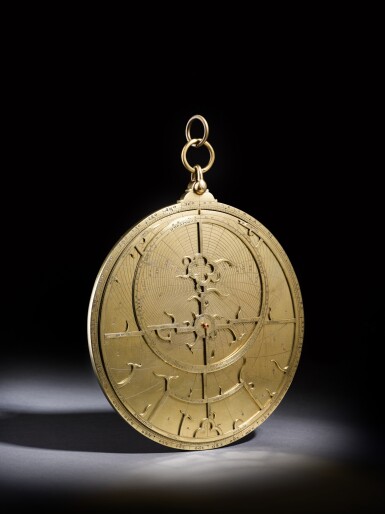Master Sculpture from Four Millennia
Master Sculpture from Four Millennia

The Property of a Distinguished English Family
Probably North Italian, first half of the 14th century
Astrolabe
Auction Closed
July 3, 02:32 PM GMT
Estimate
300,000 - 500,000 GBP
Lot Details
Description
The Property of a Distinguished English Family
Probably North Italian, first half of the 14th century
Astrolabe
with an added English plate for London and Lincoln
copper alloy
including shackle: 29cm., 11⅜in.
diameter: 22cm., 8⅝in.
Rete
The elegantly restrained strapwork consists of a quatrefoil within the upper centre of the ecliptic circle with a demi-quatrefoil, also centrally placed, beneath the arc of the equator. The positions of 42 stars are marked by lightly curved pointers. These are (in the listing by order of increasing mediation given in Davis et al):
Mirac / β Andromeda / Pantak / ζ Cetus / Enif / α Aries
Finis fluxus / η Eridanus / Menkar Cetus / Algenib / α Perseus
Augetenar / γ Eridanus / Aldebaran / α Taurus / Alhay / α Aurigae
Rigil / β Orionis / α Algevze / Orionis / not named
Alhabor / α Canis Ma / Algomeyza / α Canis mi / Markeb / ρ Pup
Egreges / μ Ursa ma / Aldiran / Leo / Alfart / α Hya
Cor Leo / α Leo / Alrucaba / ν Ursa Ma / Corvus / ghost
Dvbhe / α Ursa Ma / Cauda Leo / β Leo / Alchimec / α Virgo
Benenas / η Uma / Alramec / α Boötes / Alfeca / α CrB
Yed / δ Ophiucus / Cor scor / α Scorpio / Alhave / α Ophiucus
Razta / γ Draconis / Vega / α Lyra / Altayr / α Aquilonis
Delfi / ε Delphinus / Adige / α Cygnus / Libe / δ Capricornus
Aldiran / α Cepheus / Denebal / δ Capricornus Crvs / δ Aquarius
Alfer / β Pegasus / Denbk’ / ι Cetus / Sceder / α Cassiopeia
The ecliptic ring carries the names for the signs (some abbreviated), each divided by numbered groups of ten degrees and with division lines carried over onto the edge. There is a neatly chamfered, lobed but almost triangular Capricorn pointer, and the ends of the Capricorn ring are worked with a stylised dragon head and tail. The vertical bar that runs from the ecliptic ring to the lower equatorial arc has snapped, at the point where it meets the ecliptic circle. It is however still in position
Mater
This is composed of three circular layers with an extension forming the throne, these are the backplate itself and two rings. The upper of these is engraved with the scales described below. The plate itself is blank.
Limb
This carries a full 360° scale divided to 1° by numbered groups of ten. The zero position beneath the throne is marked by a small dot indentation, and this is repeated every 15°, thus marking the hours in an economical, but very unusual way.
Throne
This is of a double lobe form with shoulders. On the face an engraved arc carries the circle of the lower lobe to beneath the shackle. This latter is of ‘U’ form and two suspension rings are attached to it.
Back
Reading inwards from the circumference, the back is engraved with a degree scale in four quadrants 90-0-90-0-90 reading to one degree by numbered groups of 10. Within this is a zodiacal calendar (0° Aries = almost 12 March) with the month ring placed eccentrically. Within this in the upper half is an unequal hour diagram, and in the lower half, a shadow square of twelve, numbered by groups of four. Inside the shadow square, a later hand has added, rather crudely, the inscription in (partly) hollow capitals, ‘I LOND’ using a reversed ‘N’.
Plates
There are four plates for latitudes
37° Carthage and 38° Tunis
41° Armenia and 42° Rome
45° Cremona and Paris 49°
52° London and Lincoln 53°
Each is engraved with circles for the tropic of Cancer and the Equator; with almucantars drawn at 2° intervals numbered every 6°; with azimuths drawn at 10° intervals; and with arcs for the unequal hours beneath the horizon.
Given that the metal analysis, the thickness, and the script of the London/Lincoln plate are significantly different from that of the other three, it is clear that this plate was produced in a different workshop. This, given that the cities for which it is drawn and that the metal profile is similar to that of attested English instruments from the same period, was probably in England, at a date only slightly later than that of the rest of the instrument.
Components
While the alidade and shackle conform in metal analysis with the rest of the instrument, the rule and the pin have a different chemical profile and are later replacements.
A. D. Hownam-Meek (d. 1966), acquired circa 1930s;
by descent to his son R. S. Hownam-Meek (1920-2010);
by descent to the present owner, by whom successively lent to the National Maritime Museum, Royal Museums Greenwich, 1966-2024
D. Proctor, ‘Astrolabes’, in section 3 of An Inventory of the Navigation and Astronomy Collections in the National Maritime Museum, Greenwich, 1970, p. 3, inv. no. A60/66-12;
J. Davis, B. Degenaar, A. de Ruiter, R. van Gent, A. Poppot, & A. Agostini, ‘A previously unrecorded medieval Latin astrolabe and evidence for a mid-fourteenth century instrument workshop’, in Bulletin of the Scientific Instrument Society, vol. cxlvi, 2020, pp. 6-23, figs. 6 and 7
London, National Maritime Museum, Royal Museums Greenwich, 1966-2024 [long term loan]
You May Also Like









